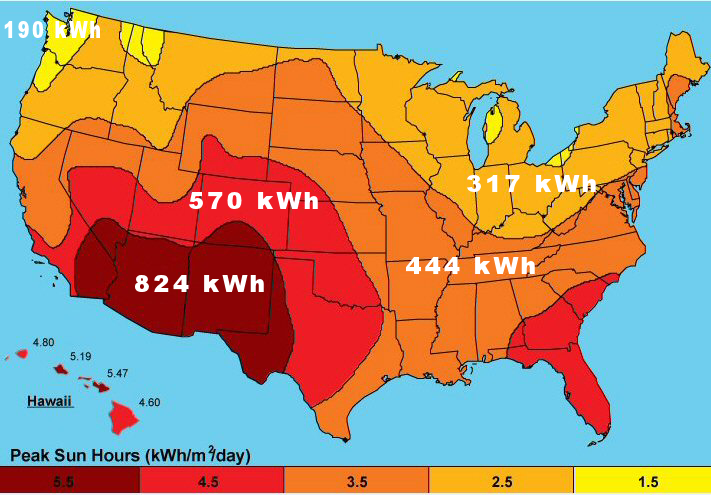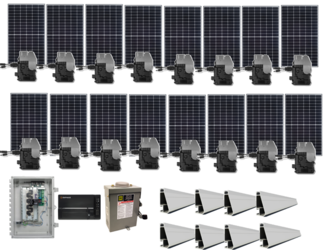We are no longer offering this product.
The below information is presented for informational purposes only. You may also find similar items in the category.- FEATURED PRODUCTS
- Solar Panels
- Solar Power Systems
- Productos Solares en Puerto Rico
- Charge Controllers
- Inverters
- Deep Cycle Batteries
- Solar Panel Mounts
- MORE PRODUCTS
- Cables & Wiring
- Enclosures, Electrical & Safety
- Inverter Power Panels & PreWired Systems
- Meters, Communications & Site Analysis
- Portable Power Systems
- Solar Water Pumps
- Voltage Converters
- Wind Turbines
- Books & Education
- * Clearance Sale *
- Hot Deals
- Open Box & Refurb Deals
Grid-Tie 5kW Solar Power System with Enphase
| Item code | Brand name | Model number |
| KITONGRID4.9ENP | AltE | Grid-Tie 5kW System |

See our video on how to use our Grid Tie Solar Calculator:
How much solar do I need for a 2000 square foot home?
5kW Grid Tie System
With Enphase Microinverters
If you're looking to install a solar power system on your home, to reduce your electric bill, these grid tie systems are a great place to start. So how much power are you currently using on a monthly basis? You'll need to look at your bill to find out. That will tell you how many kilowatt-hours (kWh) you are using each month. Then you simply plug that average monthly number into our Grid Tie Calculator, and off you go! Again, the video to the right will step you through this very simple process.
Now, for the Grid Tie System that we put together for you here - how much power will you get from this system on average, each month? Take a look on map below and find where you live. Also be sure to check out our Solar Rebates page where you can look up your state - you can save as much as 50% or more, in combination with the Federal incentives, on your installed system!

NOTE: The image of the solar panels above is representational. The correct panel will always be listed in the table below.
| 5kW Grid Tie Kit Includes: | ||
| Part Number | Item Description | Quantity |
| HEL360HSPE360B | Heliene 360 Watt Mono All Black Solar Panel | 14 |
| GENMC4KEY | Disconnect Key for MC4 Solar Panel Connector Cables | 1 |
| ENPIQ8A-72-2 | Enphase IQ8A Micro Inverter | 14 |
| ENPQ-240PORT | Enphase Q Cable IQ Micro-240 Portrait Orientation | 14 |
| ENPQ-TERM | Enphase Terminator Cap for Q Cable Connectors | 2 |
| ENPET-CLIP-10 | Enphase Micro Cable Clips, 10pk | 3 |
| ENPQ-DISC | Enphase Micro Disconnect Tool | 1 |
| ENPXIQAM1240-4 | Enphase IQ Combiner Box 4 With IQ Envoy | 1 |
| ENPCT200SPLIT | Enphase Split-Core Current Transformer 200A | 2 |
| ETNBR2152P15A | Eaton 2 Pole 15A Plug On Breaker 120/240 VAC | 2 |
| SQUDU221RB | Square D DU221RB 30A 240VAC Unfused Disconnect | 1 |
| SQUPK3GTA1 | Square D Ground Kit PK3GTA1 | 1 |
| TWOXR100168A | IronRidge XR100 14' Rail, Clear | 4 |
| TWOXR100132A | IronRidge XR100 11' Rail, Clear | 4 |
| TWOXR100-BOSSM1 | Bonded Splice Kit for XR-100 Rails | 4 |
| TWOXR100CAP | End Cap for XR-100 Rails - Pair | 4 |
| TWOUFOCLMPBK | IronRidge Universal Fastening Object (UFO), Black , Each | 34 |
| TWOUFOSTP35MMB1 | IronRidge XR Stopper Sleeve, 35MM, Black, Each | 8 |
| TWOGDLUG | IronRidge XR Grounding Lug w Hardware, Each | 2 |
| TWOFLASHVUEM1 | IronRidge FlashVue Flashing | 28 |
| TWOTBOLT | Bonding Hardware, T-Bolt | 28 |
| TWOMICROTBOLT | IronRidge Microinverter Bonding Hardware, TBolt, Each | 14 |
| HLRWESHLBL17 | NEC Label: Electric Shock Hazard | 4 |
| HLRLAM1 | Clear Over Laminate for NEC Labels | 1 |
| HLR14TURNOFFPV | NEC Label: Turn off Photovoltaic AC Disconnect | 3 |
| HLRPOWSRC17 | NEC Label: Warning Power Source Output | 1 |
| HLRELECSHKDC17 | NEC Label: Warning - Electrical Shock Hazard - DC Voltage | 1 |
| HLR14DUALPOWER | NEC Label: Warning- Dual Power Source | 2 |
| HLRPVACDIS17 | NEC Label: PV System AC Disconnect Label | 3 |
| HLRPVPOWSRC | NEC Label: Photovoltaic Power Source Label | 5 |
| HLRMPVSD | NEC Label: Main PV System Disconnect Label | 2 |
| HLRMAXVOLT17 | NEC Label: Maximum Voltage Label | 1 |
| HLRRAPID2017 | NEC Label: Rapid Shutdown Switch | 1 |
| HLRRAPID | NEC Label: Photovoltaic System Equipped With Rapid Shutdown | 1 |
| HLRACRATING | NEC Label: Inverter AC Rating Label | 1 |
* To take a look at technical spec pages, installation manuals, warranty information, etc. click on each item in the chart to go to that Spec Page.
What's in a 5kW Grid Tie Solar Power System:
- What's in a 5kW Grid tie solar system?
Solar Panels
Mounting
Combiner Box
AC and DC Disconnects
Grid Tie Inverter
altE's Solar Power Systems include the major components needed for a solar installation. Since each installation is unique, some parts/materials will need to be purchased separately to satisfy the needs of your specific project and local regulations.
1. Photovoltaic Modules (aka solar panels, solar electric panels)
The PV modules are the individual building blocks for providing power from the sun. They are typically made from silicon cells, glass, tedlar, and aluminum. Solar Panels can vary in type, size, shape, and color. The common nominal voltages for panels are 20V and 24V, in order to accomodate the voltage windows of grid tie inverters.
2. Racking/Mounting System for Solar Panels
The mounting system for the solar panels includes the hardware to permanently affix the array to either a roof, a pole, or the ground. These systems are typically made of aluminum and are customized to the mounting surface and the model of module used. It is important to consider distance from roof for flush-type roof mount installations. Restricting airflow under the modules results in higher module operating temperatures that reduce power output. With pole mounts wind loading must be considered and proper civil works must be done with the foundation for the pole as well as the possible addition of supplementary wind supports for the array frame.
3. Combiner Box
A combiner box is an electrical box where series strings of solar panels are then spliced in parallel. This is also the place where the PV series string fuses or circuit breakers are located. This allows the installer to bring the separate strings together and combine them into one positive and one negative conductor, change wire types and leave the area of the modules in conduit. They are usually outside and weather rated, so they can be right next to the array.
4. DC and AC Disconnects
The DC and AC disconnects are manual switch units that are capable of cutting off power to and from the inverter. Some inverters have disconnects integrated into the unit with switches, others can have them integrated into a power panel assembly, and some inverters leave you on your own to provide suitable disconnecting means. The disconnects are used by service personnel or authorized persons (fire/police/electric workers) to disable power from a renewable energy system (in this case PV) so that there are no live electrical parts associated with the inverter, and that no current is going to the grid that could harm utility employees in the event that they are working in your area. Homeowners or authorized personnel can use the disconnects to de-energize a system for maintenance or service.
5. Grid Tie Inverter (Micro Inverter)
The grid tie inverter is the device that takes the energy that the photovoltaic system produces in DC current form and turns it to AC current that is then sent (sold) to the electric grid. These inverters typically have a voltage input range from 100 to 500 volts DC and they convert it into 120 volts AC, 240 volts AC, or 208 volts AC. These inverters are especially sophisticated devices that must conform to special regulations in order to tie into the utility. When the power goes out in your area, it is important to know that the grid tie inverter will not allow power to be sold back to the grid. This is done to prevent electric utility workers from being injured or killed by working on power lines they thought were de-energized. When the power goes out, your power will go out as well. A grid tie inverter will not resume normal operations until the utility grid has established standard conditions for 5 straight minutes within strict parameters.
There are benefits to having a system layout with many small inverters (micro inverters) instead of a single large inverter (string inverter). First, it gives the system reliability by not having a single point of failure. If a module or an inverter is having an issue, it only affects the output of one module, as opposed to the entire system. In a single large inverter system, if one solar module is being shaded, it negatively affects the output of other modules in the system. The micro-inverter decentralizes this so that if one module is being shaded, the output of that particular module is the only one that will drop.
See our video on the different grid tie inverters, and the benefits of the Microinverter:
Common Questions:
How much is 5kW of energy?
5kW is five kilowatts and a kilowatt is a measurement of power, not energy. A kilowatt-hour, or kWh, is a unit of energy. 5 kWh is five kilowatt-hours of energy and that is enough energy to run a standard refrigerator for, on average, three days.
What is 5kW?
5kW is five kilowatts of power and is an instantaneous measurement of the rate that electric energy can be transferred in a circuit.How much is 5kw of electricity?
5kW of electricity is five kilowatts of power.A 5kW solar system installed in an ideal geographic location, with optimal tilt angle and orientation will be capable of producing up to 7,000 kWh annually. This amount can vary depending on factors like seasonality, however you can use the altE solar calculator or contact altE for a more precise estimate of production for your specific installation.How many panels in a 5kW solar system?
A 5kW home system will have 14 solar panels. This is an average number however, as the watts of each panel will determine the number of solar panels needed for a 5kW system.How much does a 5kw solar system cost?
A 5kW system costs about $10,000 for parts. If you hire a solar professional to install the system it will cost more than if you install the system yourself. Either way you will need to have an electrician do some of the work.How many amps does a 5kw solar system produce?
A 5kW solar system will produce 20 amps at 240v. This is because volts times amps equals watts, so 240 volts times 20 amps is about 5000 watts. This however is before any real world inefficiencies are introduced. So under normal conditions you will likely produce less then 20 amps most of the time.How many solar panels to generate 5kw?
14 solar panels are in a 5kW solar system. However it is important to note that this is the wattage under standard testing conditions, or STC. In the real world, due to many factors like the amount of sunlight and losses due to thermodynamics, it is very rare that you will achieve the full STC rating of the system. Therefore it is important to understand your goals when sizing a solar system.Can 5kw power a house?
Yes, a 5kW solar system can power a whole house. However it is dependent on the amount of energy you consume and the specific location where the installation is. If you need help with system sizing, give altE a call at 877-878-4060, send altE a system design request, or read some of the articles we've posted in our resource library.How big is a 5kw solar system?
A 5kW solar system takes up about 240 square feet of solar panels.How many batteries for 5kw solar system?
A standard 5kW solar system will have no batteries at all. If you want to add batteries you should look into a grid tie system with battery backup, what is commonly called a hybrid system.How much does a 5kw solar system produce?
The amount of energy a 5kW solar system produces is based on where the system is installed. Factors like geographic location, tilt angle, orientation, seasonality and others will all be factors in determining production. You can use the altE solar calculator or contact altE to determine the amount of energy your system should produce.How much energy does a 5kw solar system produce?
The amount of energy a 5kW solar system produces is largely dependent on its geographic location, tilt angle, orientation and seasonal variations. To determine the amount of energy that a particular system should produce, we suggest using the altE solar calculator or contacting altE directly. The calculator will take into account the local climate and weather patterns, as well as other variables, to provide an estimate of production.
What can a 5kW solar system run?
A 5kW solar system can run a refrigerator, a television, a computer, a phone and even an electric vehicle. The amount of energy a 5kW solar system produces is largely dependent on its geographic location, tilt angle, orientation and seasonal variations. To determine the amount of energy that a particular system should produce, and what it can run specifically, we suggest using the altE solar calculator or contacting altE directly. The calculator will take into account the local climate and weather patterns, as well as other variables, to provide an estimate of production.This item is a package made up of the following components. Please call to speak to a sales representative to learn about other options which may be available.
- 14 x Heliene 360 Watt Black Mono Solar Panel
- 1 x Disconnect Key for Staubli MC4 Connectors
- 14 x Enphase IQ8A Micro Inverter
- 14 x Enphase Energy Q Cable IQ Micro-240 Portrait
- 1 x Enphase IQ Combiner 4 with IQ Gateway
- 2 x Eaton 2 Pole 15A Plug On Breaker 120/240 VAC
- 2 x Enphase Split-Core Current Transformer 200A
- 1 x Enphase Energy Disconnect Tool for Q Cable Connectors
- 2 x Enphase Energy Terminator Cap for Q Cable Connectors
- 3 x Enphase Micro Cable Clips, Packs of 10
- 1 x Square D DU221RB 30A 240VAC Unfused Disconnect
- 1 x Square D Ground Kit pk3gta1
- 4 x Ironridge XR-100 Rail, 14 Foot Section, Clear
- 4 x Ironridge XR-100 Rail, 11 Foot Section, Clear
- 4 x IronRidge XR-100 BOSS Bonded Structural Splice
- 4 x Ironridge End Cap for XR-100 Rails - Pair (Left/Right)
- 8 x IronRidge XR Stopper Sleeve, 40MM, Black, EACH
- 34 x IronRidge Universal Fastening Object (UFO), Black , Each
- 2 x IronRidge XR Grounding Lug w Hardware, Each
- 28 x Clear (Mill) IronRidge FlashVue
- 28 x Bonding Hardware, T-Bolt, for FlashFoot 2 and L Foot, Each
- 14 x IronRidge Microinverter Bonding Hardware, TBolt, Each
- 3 x NEC 2014 Compliant Label: Turn off Photovoltaic AC Disconnect
- 1 x NEC 2017 Compliant Label: Warning - Electrical Shock Hazard - DC Voltage
- 2 x NEC 2014 Compliant Label: Warning -Dual Power Source
- 3 x NEC 2017 Compliant Label: PV System AC Disconnect Label
- 4 x NEC 2017 Compliant Label: Warning - Electrical Shock Hazard
- 5 x NEC 2020 Compliant Label: Photovoltaic Power Source
- 2 x NEC 2011 Compliant Label: Main PV System Disconnect Label
- 1 x NEC 2017 Compliant Label: Maximum Voltage Label
- 1 x NEC 2017 Compliant Label: Rapid Shutdown Switch
- 1 x NEC 2011 Compliant Label: Clear Over-Laminate for Rating Labels
- 1 x NEC 2014 Compliant Label: Photovoltaic System Equipped With Rapid Shutdown
- 1 x NEC 2011 Compliant Label: Inverter AC Rating Label
- 1 x NEC 2017 Compliant Label: Warning - Power Source - Do Not Relocate




